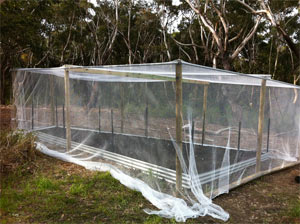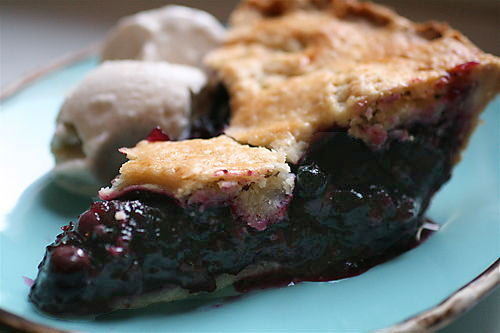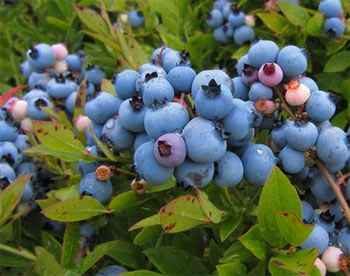Oh, the delicious things we can do with blueberries! We can eat them fresh or frozen, put them in pies, pancakes or muffins, or drop them into a smoothie. Filled with vitamins A and C, antioxidants, fiber, potassium, and minerals, they're a healthy snack anytime. Furthermore, they're not difficult to grow, and can reward you for years.
Prepping Soil for Blueberries
Blueberries are long-lived and need lots of sun. Therefore, make sure you have a place that won't be shaded by growing trees in a few years. Except for Saskatoons, all varieties prefer an acidic soil with a pH between 4.0 and 5.0. If the soil's pH isn't low enough, you can sprinkle sulfur around the bushes in the spring and fall. Blueberries also prefer sandy, well-drained soil, so if your soil has a lot of clay, add plenty of sand to help keep the roots from rotting.
Young or newly transplanted plants need lots of organic matter, so dig in compost, well-rotted manure, chopped dried oak leaves, or other items that will add nutrients while lowering the pH. Mulch with bark, woodchips, chopped oak leaves, or another substance that contributes to an acidic soil. Fertilize blueberries in late summer or early fall with a fertilizer labeled for acid-loving plants such as azaleas.
Highbush vs. Lowbush
All blueberries are native to North America. Lowbush blueberry plants are compact and well-suited for northern climates where the weather is colder. Northern Highbush blueberries can grow up to 6 feet tall, and are often grown on commercial berry farms. The hardiest varieties of Saskatoons can survive temperatures down to minus 60 degrees Fahrenheit. Southern Highbush blueberries don't need a cold winter and are a good choice for climate zones 7-10.
Spacing recommendations vary, depending on the specific variety. However, in general, allow at least 12 inches between lowbush varieties, 4 feet between highbush varieties, and 12 feet between Saskatoons, which can grow over 20 feet high.
Protecting Blueberries From Birds
Fortunately, blueberries attract few pests; unfortunately, they do attract birds. Robins and starlings in particular may eat the berries whole, peck at them, or damage them as they flutter about. There are various non-toxic, non-harmful was to control birds.
 If you want to get serious about protecting
If you want to get serious about protectingyour blueberries one of the things to use
is a lot of bird netting.
Image from Flickr: D. Beckers.
Another way to deter birds is to use a protective barrier, such as netting, over the bushes. Netting must be anchored to the ground in such a way that the birds can't get under it.
Still another way to protect your blueberries is to offer the birds food elsewhere. If you have room, plant another row of blueberry bushes for the birds, leaving it free of deterrents. Millet, sunflowers, and other berry bushes may also attract the birds, leading them away from your blueberries. A mulberry tree a short distance away may be enough to distract them away from your blueberries when used along with some other scare tactics.
Finally, a sucrose solution (table sugar) sprayed onto the plants and berries can train the birds not to eat them. Many birds cannot digest sucrose, and so learn to avoid the berries.
Cultivation
Basil is an annual. It will thrive if planted in fairly rich soil that has been warmed by the sun. It likes a sheltered position, preferably with the protection of a hedge or wall. The plant grows quickly and needs plenty of water. If, as in many town gardens, the soil tends to dry out quickly, a mulch of compost around the plant will be helpful. It is very sensitive to cold and should only be planted outside when all danger of frost has passed.
Popular Recipes for Blueberries
Basil plants have a habit of growing rather straggly or leggy. to prevent this, snip off the top shoot when the plant is about 6 inches high. Remove the flower heads as they begin to form and you will get a more compact plant.
Fusarium wilt, a soil-borne fungus, can kill young sprouts and plants. Starting seeds or cuttings in sterilized soil is important to heading off this disease, as well as obtaining seed from known Fusarium-free sources.
Downy mildew, black spot, and gray mold are foliar diseases that can affect large areas of basil plantings. They can be significant problems for commercial crops of basil, as well as for the home gardener.
Harvesting and Storing
Blueberries can be added to cakes, pies, muffins, pancakes, cereal, or just about anything. Here's a simple recipe for a great pie. If you use the graham cracker crust, you don't even have to heat up your kitchen because you won't need to use your oven.

Does this get your mouth watering, or what? (img: Wikimedia)
- 9 inch pie shell, (you can use a regular pie shell already baked, or one made with graham crackers.)
- 5 Cups blueberries
- 1 Cup sugar
- 2/3 Cup water
- ¼ Cup water
- 5 Tablespoons Flour
- Boil 3½ cups of blueberries with 2/3 cup of water and sugar.
- Mix flour and ¼ cup water into a paste and add to the boiling mixture.
- Stir until thick.
- Set aside and allow to cool.
- Add the rest of the berries and pour into the pie shell.
- Refrigerate at least 2 hours.
Helpful hints: You can also make up the pie filling and can it in quart-sized jars for use later, either as pie filling or warm it up and use it as blueberry topping for pancakes.

This is a saskatoon berry plant. Even though saskatoons look very similar to blueberries
(and have a similar taste), they are actually an entirely different species: Amelanchier alnifolia.
Blueberries are in the genus Vaccinium.
Resources
Growing Blueberries at Mother Earth News.
Growing Blueberries - planting, growing, pruning, and harvesting. At The Old Farmer's Almanac.
